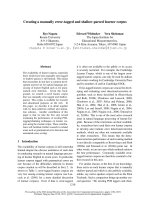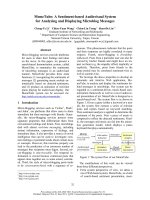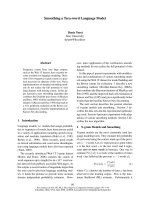báo cáo khoa học: " Half a gram – a thousand lives Lev Levinson" pptx
Bạn đang xem bản rút gọn của tài liệu. Xem và tải ngay bản đầy đủ của tài liệu tại đây (192.7 KB, 5 trang )
BioMed Central
Page 1 of 5
(page number not for citation purposes)
Harm Reduction Journal
Open Access
Commentary
Half a gram – a thousand lives
Lev Levinson
Address: Head of the Drug Policy Program, Institute for Human Rights, Moscow, Russia
Email: Lev Levinson -
Abstract
The article presents information on the latest drug policy change in the Russian Criminal Code: a
decrease of the drug threshold amounts for which possession can lead to a criminal liability. Also,
the article presents an assessment of the 2003–2004 liberal revisions in the Criminal Code, and an
analysis of the background/premise for the 2006 counter-reform. The author examines the new
criteria for establishing criminal liability and possible consequences of these changes for people who
use illicit psycho-active substances for non-medical purposes.
Introduction
Russian drug policy has moved a step backward: as of Feb-
ruary 11, 2006, RF Government Decree No. 231 of May 6,
2004 is no longer in effect. For purposes of the Criminal
Code, this document defined the mean single use doses of
every controlled psychoactive substance. Ten to fifty times
the mean dose was defined as a large amount, and a dose
fifty or more times the mean was defined as an exception-
ally large amount. The interpretation in note 2 to article
228 of the RF Criminal Code in revision No. 162-FL of
December 8, 2003 was that the criterion used for estab-
lishing criminal liability would be the mean single dose.
Now this procedure has been revised. Federal Law No. 11-
FL of January 5, 2006, which went into effect on February
11, has restored the previous model, according to which
large and exceptionally large doses are defined on the
basis of absolute amounts.
Measurement of amounts of controlled psychoactive
substances
Measurement of the amount of confiscated drugs is the
central factor determining criminal liability for illegal
drug trafficking. According to Russian laws, for acts not
involving sale (acquisition, possession, transportation,
production, or processing), the amount of the substance
involved in the act is the sole determinant of whether the
perpetrator is criminally prosecuted or is subject only to
administrative punishment in the form of a fine of up to
1000 rubles or 15 days of detention. According to article
228 of the Criminal Code, violations not involving the
sale of narcotics are a crime only if they involve a large
amount of drugs. In other words, the higher the bar set for
a large amount, the fewer criminals there will be.
The sale of narcotics, like their production for purposes of
distribution, is a criminal offense regardless of amount
involved. But even here amount plays a significant role.
According to the revision of article 228
1
of the Criminal
Code now in force, sale of an amount that is not large is
considered a felony and is punishable by incarceration for
four to eight years. Sale of narcotics in an amount defined
as large or exceptionally large is a higher class of felony;
for sale of a large amount the stipulated punishment is up
to twelve years, while for an exceptionally large amount
the punishment is up to twenty years of incarceration.
With regard to acts defined as sale it is clearly very impor-
tant to differentiate between the transfer of one or two
doses of narcotics from one drug addict to another and
Published: 24 June 2008
Harm Reduction Journal 2008, 5:22 doi:10.1186/1477-7517-5-22
Received: 13 October 2006
Accepted: 24 June 2008
This article is available from: />© 2008 Levinson; licensee BioMed Central Ltd.
This is an Open Access article distributed under the terms of the Creative Commons Attribution License ( />),
which permits unrestricted use, distribution, and reproduction in any medium, provided the original work is properly cited.
Harm Reduction Journal 2008, 5:22 />Page 2 of 5
(page number not for citation purposes)
the supply of a batch of narcotics weighing several kilo-
grams.
Background and premise for the 2003–2004 Criminal Code
Revision
One of the main problems with the Criminal Code in its
previous revision, which was in effect from December 8,
2003 to May 12, 2004, was the lack of proper regulation
of the definition of amounts of narcotics. In practice, law
enforcement agencies and courts were guided by the Sum-
mary Table from the Expert Report of the International
Narcotics Control Board, which has become infamous as
the "Babayan Table" (named for the permanent chairman
of this institution). This table is a recommendation pub-
lished by a scientific consulting agency without either offi-
cial registration or legally approved status, which is not
and could not be authorized to participate in the adoption
of regulations. In spite of this, the table has been used in
all criminal cases without exception (i.e., in hundreds of
thousands of cases annually). According to this table, a
large amount is considered to be, for example, 0.1 g of
marijuana, and 0.005 g of heroin is considered an excep-
tionally large amount. This approach to amounts made it
possible, on the basis of article 228 of the Criminal Code
(the version in effect at that time) to hold those caught
with 0.0005 g and 100 kg of heroin equally liable to a
penalty of 7 to 15 years of incarceration. When this table
was in general use, those sentenced to long periods of
incarceration were usually young people who had
acquired, possessed, sold or distributed hundredths of a
gram, while the "sharks of the narcotics business"
remained outside the purview of law enforcement agen-
cies. This single table was used to determine the criminal
liability of both classes of offenders.
The 2003 revisions to the Criminal Code in 2003 were
intended to put an end to this invidious practice. In gen-
eral, they succeeded. Although the mean single doses hur-
riedly established in spring 2004 had not been considered
in sufficient depth for all the substances on the list (as is
clear in the appended comparative table), for the most
widely used substances – heroin, marijuana, ampheta-
mines, cocaine – the doses established by the May 2004
Decree were confirmed to be realistic street doses (instead
of the arbitrary pharmacological doses in the Babayan
Table), so that it was less likely that quantities that were
actually small would be defined as large amounts.
As a result, after the new, significantly increased threshold
amounts went into effect, approximately 40,000 people
who had previously been convicted were freed or had
their sentences decreased significantly, and in 2004–2005
a minimum of 60,000 individuals who, had it not been
for the 2003 revision, would have been tried as criminals
under the article concerning possession or acquisition
without intent to sell, avoided criminal prosecution.
Causes for 2003 regressive revisions
Naturally, such a successfully implemented reform deliv-
ered a blow to vested interests, especially those of the Fed-
eral Service to Control Narcotics Trafficking. The Narcotics
Police Force, despite glowing reports, is in a very bad posi-
tion; the 40,000-person force cannot justify the resources
squandered on it. With one and a half criminal cases per
agent brought annually (and the overwhelming majority
of these cases are simple ones at that) more than 12 bil-
lion rubles a year is an unacceptable luxury. This was dis-
cussed at an expanded session of the staff of the
Prosecutor General's Office on February 3, 2006, by Pros-
ecutor General Vladimir Ustinov.
"With regard to numbers of personnel, this is the largest
such service in the world. However, if only the quality
were comparable to the quantity. Drug control agents
were responsible for bringing to light only one third of the
total number of crimes (prosecuted). The remainder con-
tinues to have been the work of the police and other law
enforcement agencies. Among completed investigations
of criminal cases only one in four were performed by these
drug control agents. And their cases took the longest and
had the lowest quality investigations. As for the nature of
the crimes they brought to light, then as before, they are
predominantly those that are superficial. These are crimes
of acquisition, possession, transport, and processing of
narcotics. But they rarely bring to light crimes that are
closer to the root of the matter, those with which the nar-
cotics chain begins and that enable the acquisition, pos-
session, production, and transport of narcotics. In the
entire year, they brought to light only 124 instances of
illegal production of narcotics, 371 cases of inducement
to drug addiction, and only a little more than 3,000 cases
involving setting up or maintaining narcotics dens."
Under these circumstances, threshold amounts became a
survival issue for the Federal Service to Control Narcotics
Trafficking.
Despite the fact that the concept of a mean single dose was
proposed in 2003 by the President of the Russian Federa-
tion and that, in public speeches of that time, the Presi-
dent argued for the need to differentiate between
approaches to drug users and to drug traffickers, the Fed-
eral Service to Control Narcotics Trafficking managed to
turn the tide in its favor. On May 6, 2005, giving in to
pressure from the Drug Control Service, the Government
submitted a draft law to the State Duma that excluded the
criteria of mean single doses from article 228 of the Crim-
inal Code.
Harm Reduction Journal 2008, 5:22 />Page 3 of 5
(page number not for citation purposes)
The result of this retreat was a change in the Criminal
Code and adoption of RF Government Decree No. 76 of
February 7, 2005, "On confirming large and exceptionally
large amounts of narcotics and psychotropic substances
for the purposes of articles 228, 228
1
[1] and 229 of the
Russian Federation Criminal Code."
Analysis of 2006 policy revisions
Now, when the regressive revision of criminal drug policy
has been completed and when, based on the new rules,
new amounts have been approved for defining large and
exceptionally large amounts, two conclusions can be
drawn on the basis of the figures:
1) Since February 11, 2006 there are additional grounds
for the criminal prosecution of people who use narcotics.
2) Despite the most recent changes, compared with the
situation existing until May 12, 2004, today's position
does not seem to be as universally repressive as it was dur-
ing the period when Academician Babayan's Summary
Table was in use.
This can be confirmed by a comparative analysis of the
threshold of criminal liability with respect to the most
important substances on the list (table 1).
If we consider the whole list, containing 232 items, we
find that a decrease in amounts defined as large occurred
in only 49 cases, while there were increases in 140. These
amounts were increased in the majority of listed sub-
stances.
However, almost all of the 140 substances for which the
amount deemed large was increased are substances only
rarely involved in illegal trafficking, while decreases in
threshold occurred for the majority of popular narcotics.
The bar for the amount criminally punishable decreased
with respect to that established on May 12, 2004: by a fac-
tor of two for heroin (from 1 to 0.5), by a factor of five for
opium (from 5 to 1 grams), for marijuana from 20 to 6
grams, for hashish from 5 to 2 grams, for ketamine by a
factor of 5 (from 1 to 0.2 grams), for cocaine by a factor of
three (from 1.5 to 0.5 grams), for LSD by a factor of 30
(from 0.003 to 0.0001 gram), for pervitine from 0.5 to 0.3
grams, for amphetamine by a factor of 5 (from 1 to 0.2
grams), and for ephedrine from 0.5 to 0.2 grams.
The situation was analogous with regard to amounts
defined as exceptionally large. These amounts were
increased for 140 substances, while they decreased for 29.
But here too, although in a smaller number of cases, the
criminal penalty was increased for the most widely dis-
tributed drugs, especially for heroin, an exceptionally
large amount of which was decreased by a factor of two
(from 5 to 2.5 grams), and also for cocaine, promedol,
and LSD.
For all substances included in List 1 (in particular, canna-
bis and its derivatives, heroin, opium, poppy straw, meth-
adone, MDMA, phencyclidine, ephedrine, cathinone, and
methqualone), the large and exceptionally large amounts
are again weighed and defined with impurities included,
regardless of their percentage admixture. This also applied
to Babayan's summary table. The same rule was estab-
lished for cocaine (in List II). In the May 12, 2004 Decree
there was no such rule, justifying insistence on measure-
ment of the weight of the pure amount of controlled sub-
stance in the mixture. It is true that for heroin, in the
majority of cases, despite the letter of the law, this was not
possible. (Investigators and experts attributed this to the
lack of the necessary equipment for extracting the
diacetylmorphine from street heroin.)
Conclusion
Decrease in the threshold entails completely different
penal consequences for different substances. The change
in amount requiring criminal penalties for marijuana
from 20 to 6 grams will not lead to a significant overall
increase in the number of those subject to criminal prose-
cution, since 5.99 grams of marijuana is still a sufficient
quantity for more than one use. However, the difference
in threshold between a gram and half a gram of heroin
will cause many drug dependent people to be incarcer-
ated. What is significant here is not just that quality of her-
oin (additives mixed with the diacetylmorphine) affects
its weight, but, most important, that heroin addiction
requires a higher dose for more frequent use. Given the
current level of heroin use, which, although decreasing, is
still very high, the number of people affected by this single
line in the table is very high. And this will increase the
number of people in prison and contribute to a new
round of growth in the prison population.
A Russian translation of the text may be read in Additional
file 1.
Harm Reduction Journal 2008, 5:22 />Page 4 of 5
(page number not for citation purposes)
Table 1: Amounts of narcotics and psychotropic substances deemed to be large and exceptionally large amounts (in grams)
Substances Babayan Table as of March 1, 2003 Decree of May 6, 2004 Decree of February, 7, 2006
large amount exceptionally
large amount
large amount exceptionally
large amount
large
amount
exceptionally
large amount
Cannabis (Marijuana) 0.1 500 20 100 6 100
Hashish 0.1 100 5 25 2 25
Cannabis oil (Hashish oil) 0.05 50 1 5 0.4 5
Heroin any amount up
to 0.005
0.005 1 5 0.5 2.5
Opium 0.1 10 5 25 1 25
Acetylated opium 0.05 5 1 5 0.5 5
Poppy straw 0.2 250 100 500 20 500
Poppy straw extract (poppy straw concentrate) 0.02 2 0.5 2.5 1 5
Methadone 0.01 1 0.5 2.5 0.5 2.5
Buprenorphine 0.0012 0.12 0.003 0.015 0.005 0.025
Morphine 0.01 1 0.1 0.5 0.1 0.5
Codeine 0.2 10 1 5 1 5
Ketamine 0.02 1 1 5 0.2 5
3-Methylfentanyl any amount up
to 0.002
0.002 0.0002 0.001 0.0002 0.001
Sodium oxybutyrate and other salts of Hydroxybutyric acid 25 250 20 100 10 50
Pentazocine 0.03 3 0.5 2.5 2 10
Trimeperidine (Promedol) 0.03 3 0.2 1 0.03 0.15
Cocaine 0.01 1 1.5 7.5 0.5 5
Cocaine hydrochloride 0.01 1 0.1 0.5 0.5 5
Home made derivatives of Ephedrine or substances containing Ephedrine 1 ml 100 ml 3 10 0.5 10
LSD any amount up
to 0.0001
0.0001 0.003 0.015 0.0001 0.005
Mescaline 0.03 5 0.5 2.5 0.5 2.5
MDMA ("Ecstasy") 0.02 1 0.5 2.5 0.6 3
Methamphetamine, Pervitine 0.02 1.5 0.5 2.5 0.3 2.5
Amphetamine (Phenamine) and combined medicinal drugs containing Phenamine
Amphetamine)
0.03 3 1 5 0.2 1
Fruit body (any part) of any species of mushroom containing Psilocibin and/or)
Psilocin
0.5 50 only the pure
substance was
counted
only the pure
substance was
counted
10 100
Psilocibin, Psilocin 0.01 0.1 0.05 0.25 0.05 0.25
Phencyclidine any amount up
to 0.01
0.01 0.05 0.25 0.02 0.1
Ephedrine (Methcathinone) 0.02 3 0.5 2.5 0.2 2.5
Cathinone 0.02 1 0.005 0.025 0.2 1
Amobarbital (Barbamyl) 0.6 30 1 5 1 5
Glutethimide (Noxyron) 1.5 25 2.5 12.5 1 12.5
Methaqualone 0.05 1 2 10 1 5
Taren 10 100 2 10 0.5 10
Publish with Bio Med Central and every
scientist can read your work free of charge
"BioMed Central will be the most significant development for
disseminating the results of biomedical research in our lifetime."
Sir Paul Nurse, Cancer Research UK
Your research papers will be:
available free of charge to the entire biomedical community
peer reviewed and published immediately upon acceptance
cited in PubMed and archived on PubMed Central
yours — you keep the copyright
Submit your manuscript here:
/>BioMedcentral
Harm Reduction Journal 2008, 5:22 />Page 5 of 5
(page number not for citation purposes)
Competing interests
The author declares that they have no competing interests.
Additional material
References
1. [ />Additional file 1
– . Russian translation of Half a gram – a thousand lives
Click here for file
[ />7517-5-22-S1.doc]









